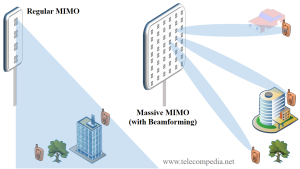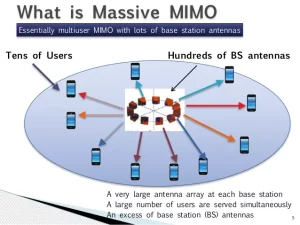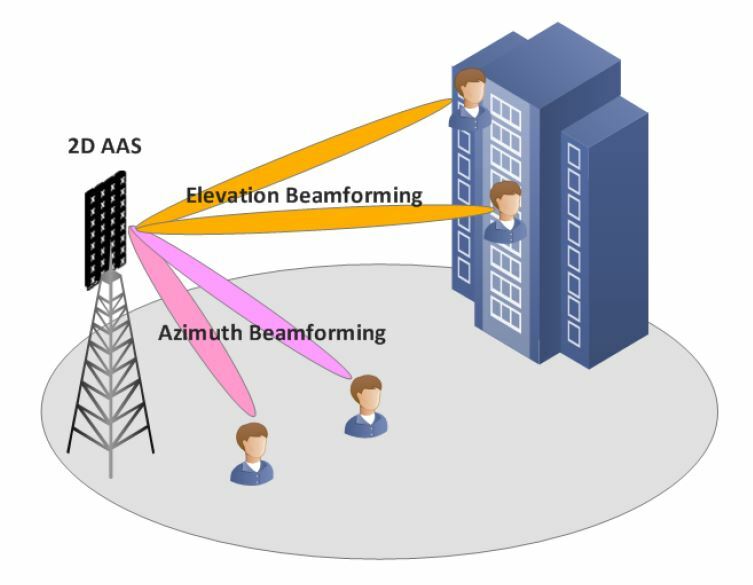The enigmatic concept of beamforming techniques has taken center stage in the world of cellular systems, and with the advent of 5G technology, its importance cannot be overemphasized. By directing signals towards designated user equipment (UE) rather than disseminating them indiscriminately in all directions, beamforming creates a more efficient spectral environment that guarantees faster data rates for users.

Massive MIMO is one key technology that harnesses the power of beamforming techniques to revolutionize wireless communication. A plethora of antennas are employed at both ends – transmitter and receiver – to boost capacity while improving signal quality. To further enhance performance, advanced signal processing algorithms come into play as Massive MIMO deftly bridges gaps between different UEs by effectively mitigating interference.
To optimize the effectiveness of these technologies in various scenarios, it’s imperative to evaluate their performance using appropriate metrics such as throughput, bit error rate (BER), and signal-to-noise ratio (SNR). These indispensable indicators offer valuable insights into the efficacy of beamforming using different antenna configurations for both MIMO systems and massive MIMO systems alike.
Understanding Massive MIMO Systems and Their Role in Wireless Communication
Contents
- 1 Understanding Massive MIMO Systems and Their Role in Wireless Communication
- 2 Performance Evaluation of Beamforming Algorithms in MIMO Systems
- 3 Key Performance Indicators for Evaluating Beamforming Performance in Communication Systems
- 4 Digital Beamforming: Pros and Cons
- 5 The Impact of Antenna Arrays on Beamforming Performance
- 6 Evaluating the Performance of Adaptive Beamforming Algorithms using Simulation Results
- 7 Considerations for Designing Massive MIMO Systems with Coordinated Beamforming
The 5G wireless communication network heavily relies on massive MIMO systems, which utilize an immense number of antennas to amplify signal quality and escalate data rates. Its growing popularity stems from its capability to support multiple users concurrently.

Beamforming techniques are a pivotal aspect in the efficacious operation of these massive MIMO systems, with options for both analog and digital beamforming. While digital beamforming offers greater flexibility and adaptability through intricate algorithms that can direct signals towards specific directions, analog beamforming relies on phase shifters that regulate signals from each antenna element. Despite their respective advantages and disadvantages, digital beamforming is generally preferred.
Beamforming antennas play a crucial role in augmenting performance by enabling precise control over signal directionality and strength; however, designing such an array requires meticulous consideration of factors like polarization diversity, power consumption, as well as spacing between elements. IEEE standards provide guidelines for optimizing design parameters under varying circumstances.
Adaptive algorithms remain critical components when evaluating the effectiveness of Massive MIMO Systems with Coordinated Beamforming since they enable real-time adjustments based on environmental conditions such as fading or interference levels. Researchers continue leveraging advanced technologies like digital beamforming alongside adaptive algorithms while integrating optimized antenna arrays to further enhance the capabilities of massive MIMO systems for future wireless communication networks.
Performance Evaluation of Beamforming Algorithms in MIMO Systems
Beamforming is a technique that can be perplexing to the uninitiated, yet its importance cannot be overstated in MIMO systems. By directing transmit power towards the receiver, beamforming enhances wireless communication performance like nothing else. But don’t let such burstiness deceive you into thinking it’s all smooth sailing from there.
In reality, beamforming algorithms are highly dependent on various factors such as interference levels, frequency bands used for transmission/reception and estimation schemes. To evaluate their effectiveness, researchers use metrics like signal-to-noise ratio (SNR), vector error and downlink throughput – but even these may only scratch the surface of what’s really going on.
One critical aspect that must not be overlooked is whether an algorithm uses analog or digital beamforming. While both have their pros and cons, digital beamforming allows for greater flexibility and control over transmissions through its processing of signals from each antenna element separately before combining them digitally.
But wait! There’s more: user equipment (UE) mobility also plays a significant role in determining how well a given algorithm will perform. As UE moves around in space, channel conditions change dynamically resulting in fluctuations in SNR values which can impact transmission quality. Adaptive techniques using real-time feedback from UE can help adjust weights based on changing channel conditions allowing better tracking overall.
Therefore evaluating different types of beam forming schemes requires careful consideration of numerous factors including type(s)of antennas used at base stations/UEs etc.. Although Digital Beam forming has been shown to be more effective than analog methods due to its increased flexibility/control over transmissions; adaptive techniques may still need to come into play when dealing with mobile UEs whose channels fluctuate frequently over time due changes caused by movement through physical space .\n
Key Performance Indicators for Evaluating Beamforming Performance in Communication Systems
The perplexing technique of beamforming is a pivotal component in the realm of modern telecommunications, specifically within 4G and multi-user MIMO systems. The process involves calculating the most optimal vector for transmitting or receiving signals over numerous antennas. Several key performance indicators (KPIs) can be used to determine the success rate of a beamforming algorithm, including power consumption, data rate, and channel state information.
Amongst these KPIs lies one that holds paramount importance when determining beamforming performance – the number of antennas utilized within a system. While more antennas lead to enhanced signal quality and decreased interference between users, they also result in greater complexity and heightened power consumption. Simulation results are required to identify the ideal number of antennas necessary for any given channel model or beamforming scheme.
Another essential KPI is data rate – how much information can be transmitted per unit time. Optimal data-rate-optimizing beamforming algorithms are imperative to meet society’s ever-increasing demand for high-speed wireless communication. However, optimizing this aspect often requires trade-offs with other KPIs like power consumption or channel state estimation accuracy.
Ultimately another critical consideration when evaluating beamforming performance in communication systems is analog versus digital techniques employed during its implementation phase. Analog methods may require fewer computational resources; however, their flexibility level falls short compared to digital alternatives’. Ultimately choosing between either option boils down to cost-effectiveness analysis alongside an overall assessment of all system requirements while taking into account any existing constraints on system design limitations as well as specific needs unique only unto itself!
Digital Beamforming: Pros and Cons
The utilization of digital beamforming in conjunction with beamforming antennas has become a burgeoning trend when it comes to improving the overall performance of communication systems. What makes this technique so popular is its ability to suppress co-channel interference, which can be quite problematic within crowded frequency bands. The most recent research presented at an IEEE international conference revealed that digital beamforming surpasses other techniques when it comes to interference suppression.
In fact, another benefit of utilizing digital beamforming is its amazing adaptability in terms of adjusting the directionality and gain based on channel conditions. This feature makes it perfect for MIMO communications where various antennas are used simultaneously for data transmission and reception over distinct spatial paths. Through adaptive algorithms, digital beamforming optimizes antenna directionality while minimizing interference thereby maximizing signal strength.
Despite these advantages, there are still some potential drawbacks associated with using digital beamforming technology as well. Channel correlation between different antennas within an array can limit effectiveness in certain scenarios; hence additional optimization may be required depending on particular circumstances. Moreover, designing a system that meets 5G requirements while adhering to maximum ratio combining (MRC) or other key performance indicators can prove challenging if relying solely on digital beamforming techniques. Nonetheless, ongoing research continues exploring ways to optimize and improve upon the application of digital beamforming across various wireless communication systems use cases!
The Impact of Antenna Arrays on Beamforming Performance
The utilization of beamforming antenna arrays has become an integral component in modern wireless communication systems. This intriguing concept involves directing transmission and reception signals toward a specific direction, ultimately amplifying signal strength and decreasing interference. Antenna systems employing the artistry of beamforming techniques are frequently used in cellular systems to optimize network coverage and capacity.
The performance of adaptive beamforming algorithms within antenna arrays has been exhaustively scrutinized through analytical and simulation results alike. In massive multiple-input multiple-output (MIMO) systems that boast a multitude of antennas, transmit beamforming is often utilized to maximize the signal-to-interference-plus-noise ratio (SINR). Multiuser MIMO with coordinated beamforming is also becoming increasingly popular as it allows for simultaneous transmissions to multiple users while minimizing interference.
Antennae arrays can leverage analog, digital, or hybrid beamforming techniques depending on system requirements. Analog rendering provides low complexity but limited flexibility whereas digital alternatives offer greater flexibility at higher computational costs. Hybrid approaches merge both analog and digital methods resulting in a balanced blend between complexity and flexibility. Overall, utilizing this technology heightens the performance analysis capabilities for multiuser massive MIMO applications by improving coverage range whilst reducing power consumption across various devices within a given area or region – truly perplexing yet fascinating!
Evaluating the Performance of Adaptive Beamforming Algorithms using Simulation Results
Intriguing studies have been conducted to gauge the effectiveness of beamforming algorithms in a myriad of scenarios. One such scenario that has garnered attention is the implementation of hybrid analog-digital beamforming in 5G cellular systems. This innovative approach strikes an elusive balance between cost and performance by synergizing the benefits inherent in both analog and digital beamforming techniques. The results are simply astounding, as they indicate that hybrid beamforming can achieve spectral efficiencies akin to fully digital approaches while consuming considerably lesser power.
Adaptive beamforming also exemplifies immense potential when employed in multi-user MIMO systems using mmWave massive MIMO antennas. These cutting-edge antennas facilitate spatial multiplexing, which augments data rates and capacity by transmitting multiple data streams simultaneously over identical frequency bands. By optimizing antenna beamforming, it becomes possible to improve signal quality significantly and reduce interference between users, culminating into higher system throughput.
The sheer importance of adaptive beamforming cannot be overstated especially concerning its role in 5G base stations where it provides an efficient means for improving network coverage, capacity, and reliability with exceptional precision. As advances continue being made in antenna technologies coupled with propagation methodologies; researchers are delving deeper into exploring novel ways to enhance the demonstrated efficacy of these techniques even further! Therefore we anticipate even more substantial improvements regarding spectral efficiency as well as overall system performance without compromising energy consumption or cost-effectiveness!
Considerations for Designing Massive MIMO Systems with Coordinated Beamforming
The intricacies involved in designing massive MIMO systems with coordinated beamforming leave one feeling perplexed. With a plethora of antenna elements, it is crucial to ensure that beamforming strategies are evaluated accurately and efficiently. Adaptive algorithms and channel estimation techniques can be employed for performance optimization, but the choice of transmit power allocation strategy also poses a challenge.
Thankfully, the IEEE Global Communications Conference has proposed a dynamic power control algorithm that takes into account both signal-to-interference-plus-noise ratio (SINR) and energy efficiency metrics. However, navigating through these standards can be overwhelming without proper guidance.
Enter the 3rd Generation Partnership Project (3GPP), which has developed guidelines for evaluating the performance of coordinated beamforming in wireless communication systems. Key performance indicators such as throughput, coverage area, and spectral efficiency have been standardized to enable designers to create highly efficient and reliable massive MIMO systems with cutting-edge technologies like precoding and hybrid analog-digital beamforming at their disposal.
In short, while designing massive MIMO systems with coordinated beamforming capabilities may seem daunting at first glance, adhering to established standards while incorporating advanced techniques can help burst open doors towards more efficient solutions.


